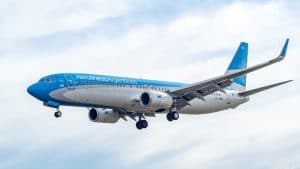How to get to Buenos Aires
Travel to Buenos Aires by plane
Buenos Aires (BUE IATA) is the international gateway to Argentina and is easily accessible from Europe and North America, along with other major cities in South America.
The main airport for international flights to and from Buenos Aires is the Ezeiza International Airport, about 35 km south of the city center.
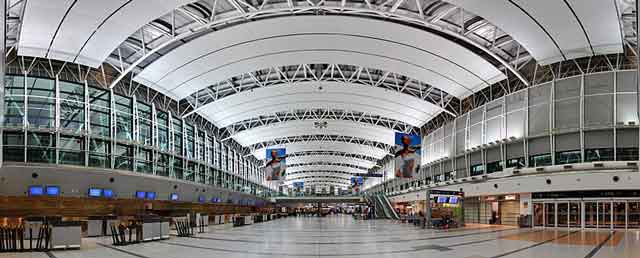
Most domestic flights use Aeroparque Jorge Newbery, a short distance from downtown Buenos Aires, while low-cost airlines are beginning to use El Palomar Airport.
Information on flights from Ezeiza International Airport and Jorge Newbery Airport is available in English and Spanish by calling +54 11 54806111 or on the website aa2000.com.ar.
Flights from Buenos Aires and the rest of Argentina are usually more expensive for foreigners. This can be a problem for short-term travelers who don’t have time to take a bus to places like Iguazú Falls, Bariloche, and Ushuaia.
The most advisable thing for foreign tourists is to book from the country of origin and through a local tourism agency a flight package that includes international and internal flights, the package as a whole is cheaper.
On the other hand, it is not advisable to buy tickets within Argentina because you will be exposed to paying an extra tax for foreigners to exchange currency.
Finally, if you are a foreigner, you must pay a reciprocity fee upon arrival at the EZE international airport. The amount depends on how much the country of origin charges Argentines to enter that country.
Ezeiza International Airport
The first and largest airport in the city of Buenos Aires. Ezeiza International Airport (called Ministro Pistarini International Airport / Ministro Pistarini International Airport EZE IATA) (located in the suburban area called Greater Buenos Aires, about 30-45 minutes from the city center by highway).
Planes fly to and from most countries in the Americas and Europe. Ezeiza is a modern airport with good services like ATMs, restaurants, free (but slow) Wi-Fi, and duty-free shops. As the main airport in a metropolitan area of 14 million people, it is surprisingly compact.
To move to Ezeiza, you should calculate approximately one hour by remis/taxi or Uber.
Although if the highway is clear you can get there in 45 minutes.
If you want something cheaper, there are two bus options: you can take the regular line 8, which will take you to/from La Boca, passing through Plaza de Mayo (make sure you take the bus that goes to the airport). Alternatively, there is another bus from Tienda León that goes to/from Puerto Madero for AR$290 (Jul 2018).
Jorge Newbery Airport
Second airport of the City of Buenos Aires . It is the airport for domestic flights about 20 minutes by taxi from the Center of Buenos Aires.
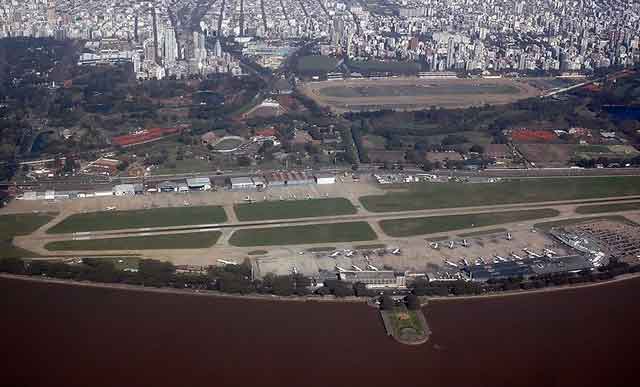
The smallest airport, used by most domestic flights. In the Aeroparque there are 2 ATMs. There is also a small exchange office, with a huge queue. Free (but very slow) Wi-Fi in the departure area.
For budget-conscious travelers, the regular bus line 33 passes just a few meters from the front door of Av. Costanera Rafael Obligado and goes to Retiro-Plaza de Mayo-San Telmo for a very low rate.
El Palomar Airport
Third airport of the City of Buenos Aires, El Palomar Airport.
El Palomar airport, which was a military base, is becoming a hub for low-cost airlines. The Fly Bondi company has regular flights to 12 destinations within Argentina.
From the door of the airport building, it is a 4-minute walk to the El Palomar commuter train station – San Martín line (when leaving the building, turn left and keep walking until you see the bridge that crosses the railway line ).
This is the safest way to get there as it is not affected by traffic jams.
The company Tienda Léon operates van services that connect the airport with Plaza Italia and Retiro for 150 pesos.
Trains to and from Buenos Aires
Long-distance trains are slowly making their way back to Argentina, but they are still few in number and limited compared to the intercity bus network. There are no international services, but using the national train to get around has finally become a somewhat viable option again.
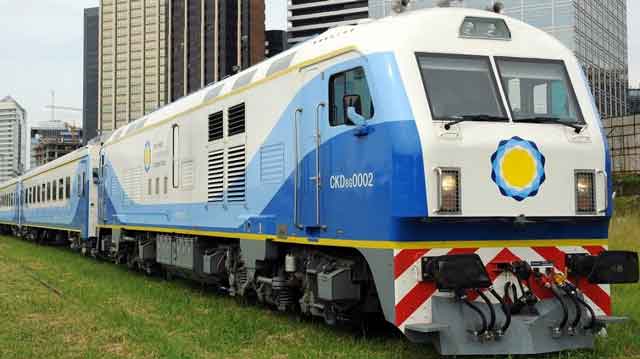
There are night sleeper services from Bahía Blanca, Córdoba and San Miguel de Tucumán, while there are day trains from Mar del Plata and Rosario. Most trains run 2-3 times a week. Ticket prices range from about AR$400 in second class to AR$1200 for bunks.
Trains from Córdoba, Tucumán and Rosario arrive at the central station of Retiro located in the center. While Mar del Plata and Bahía Blanca arrive at the Constitución Terminal.
Getting to Buenos Aires by car
Buenos Aires can be reached from any of the neighboring countries by car, but it is a long way from most borders. It is common to only get to Buenos Aires by car only from Uruguay and from the south of Brazil.
Buses in Buenos Aires
Also called “Micros” or “Colectivos” by Argentines. There are very good services that cover the whole country. In general, the more expensive the ticket, the more comfortable the bus will be. The most expensive tickets include fully reclining seats and may also have food and drinks served to you by an attendant on board.
With an almost non-existent rail system and somewhat expensive airfare prices, the long-distance bus system is well developed. Almost all long-distance buses use the huge and well-organized Retiro bus station, located on the northern edge of the city center.
The buses are mostly relatively new, however the roads they run on are relatively old; there are frequent services to most parts of the country and international bus services to neighboring countries. A second bus terminal is located in the Liniers neighbourhood, but it is much smaller and is not connected to the metro.
To get to the Retiro terminal, it is best to take a taxi or the subway (subway) that also stops there.
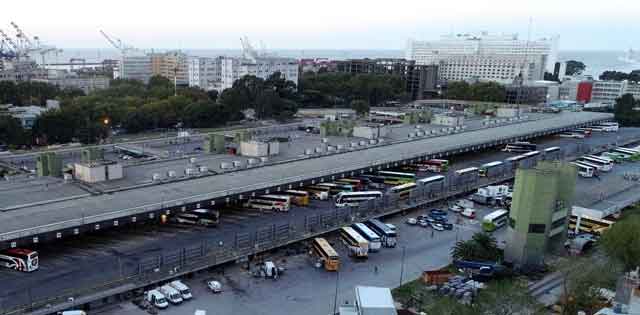
Bus travel times to/from Buenos Aires:
- Mendoza: 12-14 hours
- Cordoba: 9 hours
- Bariloche: 10 p.m.
- Iguazu: 20 hours
- Rosary: 4 hours
- Santiago de Chile: 20 hours
- Ushuaia?
- El Calafate?
- Puerto Madryn (Peninsula Valdes)
Arriving and Departing by boat from Buenos Aires to Uruguay
From Puerto Madero in the city of Buenos Aires, there are daily trips to and from Colonia and Montevideo in Uruguay.
Three companies operate these services: All three offer ferries to Colonia and connecting buses to Montevideo, Piriapolis and Punta del Este. Buquebus also offers a significantly more expensive direct ferry to Montevideo. For all three companies, tickets are cheaper if booked in advance.
The Buquebus is the most expensive but the most popular option to travel to Uruguay. To go to Colonia, they have a cheaper slow boat, as well as a slightly more expensive hydrofoil. Like the Seacat Colonia, they depart from the Dársena Norte/Puerto Madero terminal.
Dársena Norte is a modern terminal. Currency exchange, food, and car rental are available.
On the other hand, the city of Buenos Aires is an important destination for the maritime and river cruise industry in South America. The Benito Quinquela Martín Passenger Terminal, a few blocks from downtown, on Ramón Castillo street between Avenida de los Inmigrantes and Calle Mayor Luisioni, has an area of 7,100 m², a departure lounge for 1,000 passengers and luggage facilities with capacity for 2,500 suitcases. In addition, it has tourist information, craft shops, cafeterias, as well as the Immigration, Customs, Interpol and Prefecture offices.
If you want to travel from Europe to Buenos Aires by boat
Grimaldi Lines (Cargo trips). It operates a bi-monthly freighter link from Europe to South America via Africa. Five cargo ships make the rotation and each one accepts 12 passengers.
The duration of the trip is about 30 days (60 days for a round trip) and includes port calls: Hamburg, Tilbury, Antwerp, Le Havre, Bilbao, Casablanca, Dakar, Banjul, Conakry, Freetown, Salvador de Bahia, Vitória, Rio de Janeiro, Santos, Zárate, Buenos Aires, Montevideo, Paranaguá, Santos, Rio de Janeiro, Dakar, Emden, and back to Hamburg.
Only the stops in Europe and in Buenos Aires allow passengers to embark or disembark. However, passengers can visit all the ports visited.
All scales are subject to change depending on the loading and unloading needs of the ship. Tickets for a cabin on a trip from Europe to Buenos Aires start at €1,450 per person for a double cabin and €1,890 for a single cabin (more expensive deluxe cabins are available).




